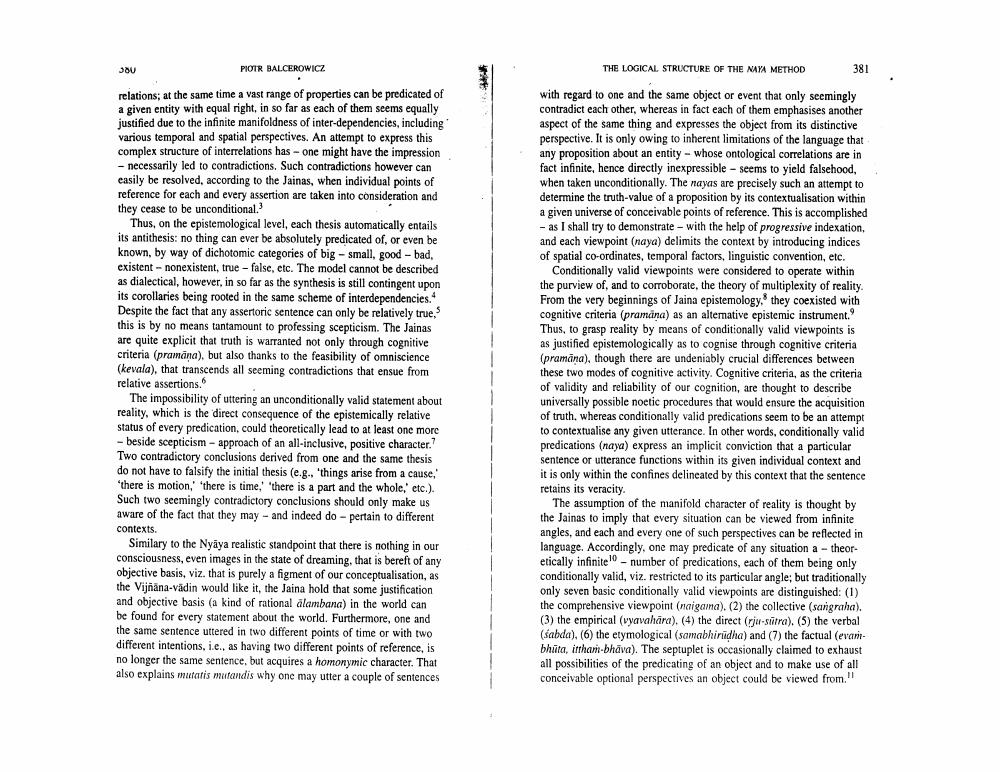________________
PIOTR BALCEROWICZ
relations; at the same time a vast range of properties can be predicated of a given entity with equal right, in so far as each of them seems equally justified due to the infinite manifoldness of inter-dependencies, including various temporal and spatial perspectives. An attempt to express this complex structure of interrelations has - one might have the impression - necessarily led to contradictions. Such contradictions however can easily be resolved, according to the Jainas, when individual points of reference for each and every assertion are taken into consideration and they cease to be unconditional.3
JOU
Thus, on the epistemological level, each thesis automatically entails its antithesis: no thing can ever be absolutely predicated of, or even be known, by way of dichotomic categories of big - small, good - bad, existent nonexistent, true false, etc. The model cannot be described as dialectical, however, in so far as the synthesis is still contingent upon its corollaries being rooted in the same scheme of interdependencies.4 Despite the fact that any assertoric sentence can only be relatively true," this is by no means tantamount to professing scepticism. The Jainas are quite explicit that truth is warranted not only through cognitive criteria (pramana), but also thanks to the feasibility of omniscience (kevala), that transcends all seeming contradictions that ensue from relative assertions."
The impossibility of uttering an unconditionally valid statement about reality, which is the direct consequence of the epistemically relative status of every predication, could theoretically lead to at least one more - beside scepticism - approach of an all-inclusive, positive character." Two contradictory conclusions derived from one and the same thesis do not have to falsify the initial thesis (e.g., 'things arise from a cause," 'there is motion, there is time,' 'there is a part and the whole, etc.). Such two seemingly contradictory conclusions should only make us aware of the fact that they may and indeed do- pertain to different
contexts.
Similary to the Nyaya realistic standpoint that there is nothing in our consciousness, even images in the state of dreaming, that is bereft of any objective basis, viz. that is purely a figment of our conceptualisation, as the Vijñäna-vädin would like it, the Jaina hold that some justification and objective basis (a kind of rational alambana) in the world can be found for every statement about the world. Furthermore, one and the same sentence uttered in two different points of time or with two different intentions, i.e., as having two different points of reference, is no longer the same sentence, but acquires a homonymic character. That also explains mutatis mutandis why one may utter a couple of sentences
THE LOGICAL STRUCTURE OF THE NAYA METHOD
with regard to one and the same object or event that only seemingly contradict each other, whereas in fact each of them emphasises another aspect of the same thing and expresses the object from its distinctive perspective. It is only owing to inherent limitations of the language that any proposition about an entity - whose ontological correlations are in fact infinite, hence directly inexpressible - seems to yield falsehood, when taken unconditionally. The nayas are precisely such an attempt to determine the truth-value of a proposition by its contextualisation within a given universe of conceivable points of reference. This is accomplished - as I shall try to demonstrate with the help of progressive indexation, and each viewpoint (naya) delimits the context by introducing indices of spatial co-ordinates, temporal factors, linguistic convention, etc. Conditionally valid viewpoints were considered to operate within the purview of, and to corroborate, the theory of multiplexity of reality. From the very beginnings of Jaina epistemology, they coexisted with cognitive criteria (pramana) as an alternative epistemic instrument. Thus, to grasp reality by means of conditionally valid viewpoints is as justified epistemologically as to cognise through cognitive criteria (pramāna), though there are undeniably crucial differences between these two modes of cognitive activity. Cognitive criteria, as the criteria of validity and reliability of our cognition, are thought to describe universally possible noetic procedures that would ensure the acquisition of truth, whereas conditionally valid predications seem to be an attempt to contextualise any given utterance. In other words, conditionally valid predications (naya) express an implicit conviction that a particular sentence or utterance functions within its given individual context and it is only within the confines delineated by this context that the sentence retains its veracity.
381
The assumption of the manifold character of reality is thought by the Jainas to imply that every situation can be viewed from infinite angles, and each and every one of such perspectives can be reflected in language. Accordingly, one may predicate of any situation a- theoretically infinite number of predications, each of them being only conditionally valid, viz. restricted to its particular angle; but traditionally only seven basic conditionally valid viewpoints are distinguished: (1) the comprehensive viewpoint (naigama). (2) the collective (sangraha). (3) the empirical (vyavahāra), (4) the direct (rju-sutra). (5) the verbal (sabda), (6) the etymological (samabhirudha) and (7) the factual (evambhūta, ittham-bhava). The septuplet is occasionally claimed to exhaust all possibilities of the predicating of an object and to make use of all conceivable optional perspectives an object could be viewed from."




